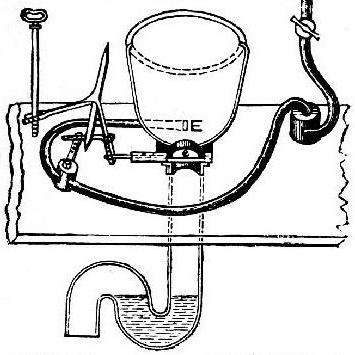While Sir John Harrington may not be remembered as a prolific poet, his name is indelibly linked to a far more practical and enduring invention: the flushing lavatory. This seemingly simple device revolutionized sanitation and public health, and its origins are rooted in the intriguing life of this Elizabethan figure.
A godson of Queen Elizabeth I, John Harrington experienced both royal favor and royal displeasure. His witty but sometimes risqué stories led to a period of banishment from court. Exiled to Kelston near Bath between 1584 and 1591, this period of forced retreat proved surprisingly productive. It was during this time that Harrington designed and installed the very first flushing lavatory in his Kelston home, which he playfully named “Ajax.”
 Cumming’s water closet patented in 1775, showcasing early flushing toilet technology and highlighting the historical progression from Harrington's original invention.
Cumming’s water closet patented in 1775, showcasing early flushing toilet technology and highlighting the historical progression from Harrington's original invention.
Fortune turned again for John Harrington when Queen Elizabeth I eventually pardoned him. In 1592, she visited his Kelston estate, where Harrington proudly showcased his innovative creation. The Queen herself was reportedly so impressed after trying out the “Ajax” that she ordered one for her own use, marking an early royal endorsement of this groundbreaking invention.
Harrington’s water-closet was a sophisticated piece of engineering for its time. It featured a pan sealed with a leather-faced valve at the bottom, connected to a cistern. A system of handles, levers, and weights controlled the release of water to flush waste away, a remarkable precursor to modern toilet technology.
Despite the Queen’s enthusiasm, John Harrington’s flushing lavatory did not immediately catch on with the wider public. For many years, the chamber pot remained the standard household convenience. The practice of emptying chamber pots out of windows into the street was common, even leading to the French warning cry “gardez-l’eau” (watch out for the water!), which some believe may be the origin of the English term “loo” for lavatory.
It wasn’t until almost two centuries later, in 1775, that Alexander Cummings of London patented a flushing water-closet design similar to Harrington’s Ajax. The widespread adoption of the flushing lavatory was further driven by the Public Health Act of 1848, which mandated that every new house should include a “w.c., privy, or ash-pit.”
Thus, it took nearly 250 years for Sir John Harrington’s ingenious invention to become a standard feature of homes. His story serves as a testament to the fact that even with royal approval, widespread acceptance of truly novel inventions can be a slow process, but their lasting impact can be profound. While his poetry may be forgotten, Sir John Harrington’s legacy as the inventor of the flushing lavatory ensures his enduring place in history.

